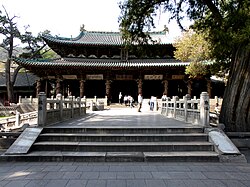Jinci
You can help expand this article with text translated from the corresponding article in Chinese. (October 2021) Click [show] for important translation instructions.
|


The Jinci or Jin Temple (晉祠) is the most prominent temple complex in Shanxi, China. It is located 16 miles (25 km) southwest of Taiyuan at the foot of Xuanweng Mountain at the Jin Springs. It was founded about 1,400 years ago and expanded during the following centuries, resulting in a diverse collection of more than 100 sculptures, buildings, terraces, and bridges.
The best known structure at Jinci is the Hall of the Holy Mother (圣母殿, Shèngmǔdiàn), which was constructed from 1023 to 1032 during the Song dynasty. [1] It has carved wooden dragons coiled around the eight pillars that support its upward-curving double-eave roof. The complex includes a classical garden with a 3,000-year-old cypress dating from the Zhou Dynasty. To the west of Hall of the Holy Mother is a temple dedicated to the deity Shuimu.[2] Next to Jinci is the Wang Family Hall, a private villa built in 1532 for Wang Qiong, a high-ranking official during the Ming Dynasty.
References
[edit]- ^ "Jinci Temple". China-tour.cn. Archived from the original on 19 August 2014. Retrieved 15 August 2014.
- ^ Hoevels, Fritz Erik (1999). Mass Neurosis Religion: Colleted Essays about the Psychoanalysis of Religion. Ahriman-Verlag GmbH. pp. 196–197. ISBN 9788391176320.




